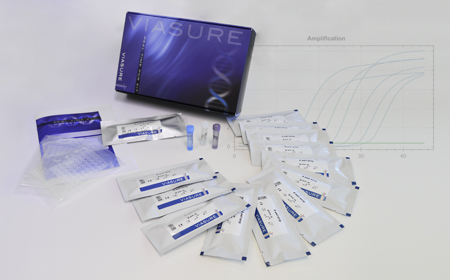
VIASURE Real Time PCR Detection Kits
H. pylori + Clarithromycin resistance

Description
VIASURE H. pylori + Clarithromycin resistance Real Time PCR Detection Kit is designed for the specific identification of H. pylori and detection of clarithromycin (CLR) resistance in H. pylori in gastric tissue biopsies from patients with signs and symptoms of gastrointestinal infection.
This test is intended to be used as an aid in the diagnosis of H. pylori and its resistance to clarithromycin in combination with clinical and epidemiological risk factors.
DNA is extracted from gastric tissue biopsies, multiplied using Real Time amplification and detected using specific primers and a fluorescent reporter dye probe for H. pylori and clarithromycin resistance in H. pylori. The assay for detecting CLR resistance in H. pylori is based on detection of point mutations in the 23S rRNA gene.
Specifications
Information
The genus Helicobacter belongs to the family Helicobacteriaceae of the order Campylobacterales. Helicobacter pylori (H. pylori) is a gram-negative microaerophilic spiral-shaped bacterium, which is able to colonize the mucus layer of the human stomach and the upper part of small intestine (duodenum).
More than half of the world population is estimated to be infected with H. pylori, but most individuals are asymptomatic. The new infections might be due to direct person-to-person transmission, via either an oral-oral, fecal-oral route or both. Nevertheless, the role of coccoid form of H. pylori as a vehicle of infection from food and water sources should not be discarded. H. pylori is involved in the pathogenesis of atrophic gastritis,
gastroduodenal ulcer, gastric cancer and gastric mucosa-associated lymphoid tissue (MALT) lymphoma.
At present, several diagnostic assays for H. pylori detection are available and grouped as “invasive” or “noninvasive”, but none of them can be considered as gold standard alone. Invasive methods include histology, culture and rapid urease testing, which require gastric biopsy specimens obtained by gastroduodenoscopy. Noninvasive approaches include fecal antigen detection, serologic testing, and urea breath testing among
others.
Urease is an important factor for the maintenance and virulence of the bacterium in the gastric mucosa. It is composed of two structural subunits encoded by genes, ureA and ureB, which have been frequently employed as target genes for the specific detection of Helicobacter pylori.
Clarithromycin is a bacteriostatic antibiotic mostly used in childhood to treat upper and lower respiratory tract infections, but, its application to treat H. pylori is the most used indication. The main action mode of clarithromycin as one of the wide-spectrum antibiotics used in H. pylori therapy is to prevent protein translation. Following the first exposure to the clarithromycin, spontaneously mutations (in both 23S rRNA operons) confer H. pylori resistance genotype and phenotype. The direct impact of these mutations is emergence of H. pylori strains resistant to clarithromycin. To now, two major mutations A2142G and A2143G were listed as main cause of antibiotic resistance in clinical isolates.

